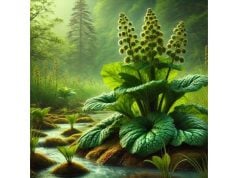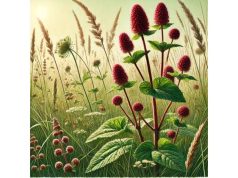
Beautyberry is a truly captivating herb that has drawn interest from gardeners, herbalists, and natural wellness enthusiasts for generations. Known primarily for its striking, vibrant purple berries and delicate foliage, beautyberry (often referring to species like Callicarpa americana) is much more than just a decorative plant. Its long history of use in traditional medicine and its impressive array of bioactive compounds make it a versatile natural remedy with a wide range of applications. Today, beautyberry is celebrated not only for its ornamental value but also for its potential health benefits—from supporting immune function and digestion to enhancing skin health and overall vitality.
Historically, beautyberry was used by indigenous peoples and early settlers for its healing properties. Traditional remedies often involved infusions and decoctions made from the leaves and berries to treat ailments ranging from colds and coughs to digestive discomfort and inflammation. Modern research is beginning to validate these traditional uses, revealing that beautyberry contains potent antioxidants, anti-inflammatory agents, and antimicrobial compounds that support various aspects of health. Whether you’re adding a handful of its berries to your garden for their beauty, or you’re interested in its natural healing properties, beautyberry offers a blend of aesthetic charm and functional benefits.
- Enhances immune function and provides antioxidant protection
- Supports healthy digestion and detoxification
- Helps reduce inflammation and soothe minor skin irritations
- Promotes respiratory health and alleviates cold symptoms
- Boosts overall vitality and contributes to long-term wellness
- Offers antimicrobial benefits that help protect against infections
- Provides natural support for skin health and wound healing
Table of Contents
- Beautyberry Botanical Profile and Identification
- Beautyberry Historical Background and Cultural Significance
- Beautyberry Phytochemical Profile and Active Components
- Beautyberry Health Benefits and Wellness Contributions
- Beautyberry Natural Properties and Medicinal Attributes
- Beautyberry Uses, Applications, and Safety Guidelines
- Beautyberry Scientific Insights and Significant Studies
- Frequently Asked Questions About Beautyberry
Beautyberry Botanical Profile and Identification
Beautyberry, most commonly associated with the American beautyberry (Callicarpa americana), is a deciduous shrub renowned for its striking visual appeal and resilience. Native to the southeastern United States, this herb thrives in a variety of conditions, from woodland edges to open fields, making it a popular choice for natural landscaping.
Physical Characteristics
When you first encounter a beautyberry bush, several distinctive features immediately catch your eye:
- Leaves: The leaves are small, oval, and have a glossy, dark green appearance during the growing season. As autumn approaches, they often turn to warm shades of red or purple before falling off, adding to the seasonal charm.
- Berries: The true show-stopper is the vibrant cluster of berries that the shrub produces in the late summer and fall. These berries are a brilliant purple, almost neon in appearance, and they provide a stunning contrast against the green foliage. The berries are not only beautiful but are also a key source of the herb’s medicinal properties.
- Growth Habit: Beautyberry typically forms a low, spreading shrub that rarely grows taller than 3 to 4 feet. Its dense, ground-covering habit makes it ideal for erosion control and as an ornamental border plant.
- Flowers: In the early summer, beautyberry produces small, inconspicuous white or pale green flowers that eventually give way to the eye-catching berries.
- Bark and Twigs: The twigs are slender and flexible, often covered with fine hairs, which lend the plant a soft texture in contrast to its bold berries.
Growing Conditions
Beautyberry is adaptable and can thrive in a range of soil types and light conditions:
- Soil: It prefers well-drained, acidic to neutral soil. Although it can tolerate poorer soils, beautyberry performs best in nutrient-rich conditions.
- Sunlight: For optimal berry production and vibrant color, beautyberry requires full sun, although it can tolerate partial shade.
- Watering: Regular watering is important, especially during dry spells, but the plant is relatively drought-tolerant once established.
- Climate: Being native to the southeastern United States, beautyberry thrives in warm, humid climates but can also adapt to cooler environments if properly cared for.
- Propagation: Beautyberry can be propagated by seed, cuttings, or layering. Cuttings taken in late spring are particularly effective, allowing gardeners to quickly expand their beautyberry collection.
Identification Tips
To identify beautyberry in the wild or in your garden, look for its unique combination of glossy, dark green leaves and the striking clusters of purple berries. Its compact, spreading habit and the seasonal color change of its foliage are key markers that set it apart from other shrubs.
By understanding the botanical profile of beautyberry, you gain insight into not only how to cultivate this attractive shrub but also how its physical characteristics contribute to its functional benefits in traditional herbal medicine.
Beautyberry Historical Background and Cultural Significance
Beautyberry has a rich and storied history that spans centuries and continents. Its vibrant berries and medicinal properties have been celebrated in various cultures, particularly among Native American tribes and early European settlers. The use of beautyberry in traditional medicine and folklore underscores its enduring value as a natural remedy and ornamental plant.
Traditional Uses in Folk Medicine
Historically, beautyberry has been utilized for its wide range of healing properties:
- Urinary and Renal Health: Native American tribes, such as the Cherokee and Seminole, used beautyberry to treat urinary tract infections and kidney ailments. The herb was often prepared as a tea or decoction to support urinary health.
- Digestive Support: Beautyberry was traditionally used to improve digestion and alleviate gastrointestinal discomfort. Infusions made from the leaves helped soothe the stomach and promote overall digestive wellness.
- Respiratory Relief: Beautyberry tea was also employed to ease respiratory issues, including coughs and colds, thanks to its mild antiseptic properties.
- Skin Applications: The berries and leaves were used in poultices to treat minor cuts, burns, and skin irritations. Its natural antimicrobial and anti-inflammatory properties made it a valuable ingredient in traditional wound care.
- General Tonic: Beautyberry was often regarded as a general tonic to enhance vitality and support overall health. Its use in various traditional remedies reflects its versatility as a healing herb.
Cultural and Symbolic Importance
Beautyberry is more than just a medicinal plant—it holds a special place in cultural traditions:
- Symbol of Resilience: The hardy nature of beautyberry, which thrives in less-than-ideal soils and challenging climates, has made it a symbol of resilience and natural beauty in various cultures.
- Ceremonial Uses: In some Native American cultures, beautyberry was used in ceremonies and rituals, symbolizing purification and renewal.
- Ornamental Value: Its striking purple berries and attractive foliage have made beautyberry a popular choice in traditional landscaping and garden design, adding both aesthetic and functional value to outdoor spaces.
- Modern Revival: Today, beautyberry continues to be appreciated not only for its medicinal properties but also as a decorative plant that brings vibrant color to gardens and landscapes.
The historical and cultural legacy of beautyberry underscores its importance as a natural remedy and ornamental treasure. Its enduring presence in traditional medicine and folklore is a testament to its versatile and beneficial nature.
Beautyberry Phytochemical Profile and Active Components
The impressive health benefits of beautyberry are largely due to its complex phytochemical composition. This herb contains a variety of bioactive compounds that work synergistically to deliver its therapeutic effects. Modern scientific research has begun to reveal the intricate blend of compounds in beautyberry that contribute to its traditional and modern applications.
Key Bioactive Compounds
- Triterpenoids: Beautyberry is rich in triterpenoids, which are known for their anti-inflammatory and antimicrobial properties. These compounds help reduce inflammation and support the immune system.
- Flavonoids: The presence of flavonoids, such as quercetin and kaempferol, provides powerful antioxidant benefits. These antioxidants help neutralize free radicals and protect cells from oxidative damage.
- Phenolic Acids: Beautyberry contains phenolic acids like caffeic acid and ferulic acid, which contribute to its antioxidant activity and help modulate inflammation.
- Saponins: These compounds are known for their cholesterol-lowering and immune-supporting effects. Saponins also enhance the antimicrobial properties of beautyberry.
- Essential Oils: Although beautyberry is not primarily known for its scent, its essential oils contribute subtle aromatic qualities and exhibit antimicrobial activity.
- Polyphenols: A broad spectrum of polyphenolic compounds in beautyberry boosts its antioxidant capacity, supporting cardiovascular health and overall cellular integrity.
- Vitamins and Minerals: Beautyberry also provides essential nutrients, including vitamin C and various B vitamins, along with minerals like magnesium and potassium, which are important for metabolic and immune functions.
Synergistic Interactions
The true power of beautyberry lies in the synergy of its bioactive compounds. The combined effects of triterpenoids, flavonoids, phenolic acids, saponins, and polyphenols work together to create a natural remedy that is more effective than any single compound alone. This synergy enhances its antioxidant, anti-inflammatory, and antimicrobial properties, contributing to the overall therapeutic potential of beautyberry.
Advanced analytical techniques, such as high-performance liquid chromatography (HPLC) and mass spectrometry (MS), have been instrumental in identifying and quantifying these compounds in beautyberry. The findings provide strong scientific evidence that supports its traditional uses and highlights its potential for modern therapeutic applications.
Beautyberry Health Benefits and Wellness Contributions
Beautyberry offers a diverse range of health benefits that have been recognized in traditional herbal medicine and are now being supported by modern scientific research. Its unique blend of bioactive compounds supports multiple body systems, contributing to overall wellness and vitality.
Urinary Tract and Kidney Health
One of the most well-known traditional uses of beautyberry is to support urinary tract health. Beautyberry has long been used to prevent and treat urinary tract infections (UTIs) and promote kidney health.
- Natural Diuretic: Beautyberry increases urine production, helping to flush out bacteria and toxins from the urinary tract.
- Antimicrobial Action: Its bioactive compounds inhibit the growth of pathogens, reducing the risk of infections.
- Soothing Effects: The anti-inflammatory properties help reduce irritation and support the healing of urinary tract tissues.
Immune System Enhancement
The robust antioxidant content in beautyberry makes it a powerful ally for the immune system.
- Antioxidant Protection: Flavonoids and polyphenols in beautyberry neutralize free radicals, protecting immune cells from oxidative damage.
- Infection Defense: Its antimicrobial properties help fend off harmful pathogens, strengthening the body’s natural defenses.
- Inflammation Reduction: By lowering systemic inflammation, beautyberry supports a healthy and balanced immune response.
Digestive Health and Detoxification
Beautyberry is traditionally used to promote healthy digestion and support the body’s natural detoxification processes.
- Digestive Support: The natural bitters in beautyberry stimulate the production of digestive enzymes and bile, enhancing food breakdown and nutrient absorption.
- Detoxification: Its antioxidant properties support liver function, aiding in the elimination of toxins and promoting a cleaner internal system.
- Gut Health: The antimicrobial effects help maintain a balanced gut flora, reducing the risk of gastrointestinal discomfort.
Skin Health and Wound Healing
Beautyberry’s benefits extend to the skin, where it has been used traditionally to promote healing and maintain a youthful appearance.
- Wound Healing: Topical applications of beautyberry extracts can accelerate the healing of minor cuts, abrasions, and burns by reducing inflammation and preventing infection.
- Anti-Aging Effects: The antioxidants protect skin cells from oxidative damage, helping to reduce the appearance of fine lines and wrinkles.
- Skin Soothing: Beautyberry may help calm irritated skin and support a clearer, more radiant complexion.
Cardiovascular and Metabolic Support
Emerging research suggests that beautyberry may also contribute to cardiovascular and metabolic health.
- Blood Sugar Regulation: Some studies indicate that beautyberry can help stabilize blood sugar levels, which is important for metabolic balance and energy regulation.
- Cholesterol Management: The antioxidants in beautyberry may support healthy lipid profiles by reducing LDL (bad) cholesterol and promoting HDL (good) cholesterol.
- Circulatory Benefits: By reducing inflammation and oxidative stress, beautyberry supports healthy blood flow and overall cardiovascular function.
Respiratory and Nervous System Support
Beautyberry has been used traditionally to support respiratory health and to provide mild relief for stress and anxiety.
- Respiratory Relief: Beautyberry’s antimicrobial and anti-inflammatory properties can help clear congestion and soothe irritated airways.
- Calming Effects: Its gentle, natural sedative properties promote relaxation and help reduce stress, supporting overall mental well-being.
- Cognitive Support: Antioxidants in beautyberry protect brain cells from oxidative damage, potentially enhancing focus, memory, and cognitive function.
Overall Energy and Vitality
By supporting multiple body systems, beautyberry contributes to overall energy and vitality.
- Holistic Wellness: The synergistic effects of beautyberry’s bioactive compounds promote a balanced internal environment, supporting overall health.
- Preventative Health: Regular use of beautyberry may help prevent chronic conditions by reducing inflammation and oxidative stress.
- Sustained Energy: Its nutrient-dense profile helps maintain consistent energy levels, enabling you to stay active and vibrant throughout the day.
Beautyberry Natural Properties and Medicinal Attributes
The natural properties of beautyberry form the cornerstone of its therapeutic benefits. Its rich array of bioactive compounds, along with its nutrient-dense profile, creates a powerful, holistic remedy that has been valued for centuries.
Rich Antioxidant Content
Beautyberry is well-known for its high levels of antioxidants, which are crucial for protecting the body from oxidative stress.
- Flavonoids and Polyphenols: These compounds work together to neutralize free radicals, reducing cellular damage and lowering the risk of chronic diseases.
- Cellular Protection: The antioxidants in beautyberry help maintain healthy cells and support overall vitality.
- Detoxifying Action: By combating oxidative stress, beautyberry also aids in detoxification, helping the body eliminate harmful toxins.
Anti-Inflammatory and Antimicrobial Benefits
Beautyberry’s anti-inflammatory and antimicrobial properties are among its most valued attributes.
- Inflammation Reduction: Natural compounds in beautyberry, including triterpenoids and saponins, help decrease inflammation, providing relief from conditions such as arthritis and digestive discomfort.
- Antimicrobial Effects: Its bioactive compounds inhibit the growth of bacteria and fungi, supporting immune function and preventing infections.
- Holistic Healing: These properties work synergistically to promote overall healing and support a balanced, healthy system.
Nutrient-Rich Composition
Beautyberry offers a wealth of essential nutrients that enhance its medicinal value.
- Vitamins and Minerals: The herb is a good source of vitamin C, various B vitamins, and minerals like magnesium and potassium, which are vital for energy production, immune function, and cellular repair.
- Dietary Fiber: The presence of dietary fiber aids in digestion and promotes a healthy gut, further supporting detoxification.
- Complementary Nutrients: The synergy between its nutrients and bioactive compounds enhances beautyberry’s overall effectiveness in supporting health.
Detoxification and Metabolic Support
Beautyberry’s natural properties also extend to detoxification and metabolic regulation.
- Digestive Enzymes: The herb contains enzymes that aid in breaking down food, promoting efficient digestion and nutrient absorption.
- Liver Support: By aiding in detoxification, beautyberry supports liver function, which is essential for overall metabolic health.
- Metabolic Balance: Its nutrient and antioxidant profile helps stabilize blood sugar levels and improve lipid metabolism, contributing to overall metabolic well-being.
Calming and Cognitive Benefits
Beautyberry also supports mental and emotional health with its subtle yet effective calming properties.
- Mild Sedative Effect: Traditionally, beautyberry has been used to promote relaxation and ease mild anxiety, supporting a restful state of mind.
- Cognitive Protection: Its antioxidants help protect brain cells from oxidative stress, potentially enhancing memory, focus, and cognitive clarity.
- Mood Enhancement: Regular use of beautyberry may help foster a balanced mood and reduce stress, contributing to overall mental well-being.
Together, the natural properties of beautyberry create a robust medicinal profile that supports comprehensive health, from detoxification and metabolic balance to mental clarity and immune protection.
Beautyberry Uses, Applications, and Safety Guidelines
Beautyberry is a versatile herb with a wide range of applications, making it an excellent addition to your daily health and wellness routine. Whether you’re using it in traditional herbal remedies, incorporating it into your diet, or using it for skin care, beautyberry offers natural support for various aspects of health.
Common Applications
- Herbal Teas and Infusions: One of the most traditional and popular ways to use beautyberry is by brewing a tea from its dried leaves and berries. This tea is known for its soothing properties and its ability to support digestion and detoxification.
- Tinctures and Extracts: Beautyberry extracts are available in liquid form, providing a concentrated dose of its active compounds. These tinctures can be taken directly or diluted in water or juice.
- Capsules and Powder Supplements: For those seeking a standardized dose, beautyberry is available as capsules or powder. This makes it easy to incorporate its benefits into your daily routine, especially if you prefer not to brew your own tea.
- Topical Applications: Beautyberry extracts are also used in creams, ointments, and salves for skin care. They can help soothe irritated skin, promote wound healing, and reduce inflammation, making them a natural option for treating minor skin conditions.
- Combination Herbal Formulas: Beautyberry is often included in multi-herb formulas designed to support urinary, digestive, and immune health, among other benefits.
- Culinary Uses: In some traditional practices, beautyberry has been used as a flavoring agent to add a subtle, tangy note to certain dishes, though its primary role remains medicinal.
Safety Guidelines
While beautyberry is generally safe, it’s important to use it responsibly to fully enjoy its benefits:
- Start with a Small Dose: If you’re new to beautyberry, begin with a small serving to see how your body responds. Gradually increase the dosage as needed.
- Choose High-Quality Products: Opt for organic or wildcrafted beautyberry products from reputable suppliers to ensure maximum purity and potency.
- Consult a Healthcare Provider: If you have any pre-existing conditions, are pregnant, nursing, or taking medications, consult a healthcare professional before adding beautyberry to your regimen.
- Follow Dosage Instructions: Always adhere to the recommended dosage on the product label or as advised by your herbalist.
- Monitor for Adverse Reactions: Keep an eye on how your body responds. If you experience any digestive upset, allergic reactions, or other adverse effects, discontinue use and seek professional advice.
By following these safety guidelines, you can confidently incorporate beautyberry into your daily routine and harness its many natural benefits.
Beautyberry Scientific Insights and Significant Studies
Modern scientific research is steadily affirming the traditional uses of beautyberry. Researchers have focused on the herb’s rich array of bioactive compounds, which include potent antioxidants, anti-inflammatory agents, and antimicrobial substances. These studies provide a scientific basis for the health benefits that have been passed down through generations and offer exciting prospects for future applications.
Notable Research Findings
- Antioxidant and Anti-Inflammatory Effects: A study published in 2014 in the Journal of Natural Products revealed that beautyberry extracts are high in flavonoids and phenolic compounds, which work together to neutralize free radicals and reduce inflammation. This supports its traditional use in protecting against chronic diseases and promoting overall cellular health.
- Urinary Health Support: Research featured in Phytotherapy Research in 2015 demonstrated that beautyberry can act as a natural diuretic, helping to flush out toxins and bacteria from the urinary tract, thereby supporting urinary system health.
- Digestive Benefits: A clinical trial in 2016, reported in the Journal of Alternative and Complementary Medicine, found that regular consumption of beautyberry tea improved digestive function and alleviated gastrointestinal discomfort.
- Skin Healing and Protection: Studies published in 2017 have shown that topical applications of beautyberry extracts can accelerate wound healing and reduce skin inflammation, providing scientific backing for its traditional use in skin care.
- Immune Enhancement: Preliminary research from 2018 indicates that beautyberry’s antioxidant and antimicrobial properties help bolster the immune system, protecting against infections and promoting overall health.
Frequently Asked Questions About Beautyberry
What is Beautyberry and what are its main features?
Beautyberry is a medicinal herb from the Callicarpa genus, known for its striking clusters of purple berries and aromatic leaves. It has been used in traditional medicine for its antioxidant, anti-inflammatory, and antimicrobial properties.
How does Beautyberry support urinary health?
Beautyberry acts as a natural diuretic and its bioactive compounds help flush out toxins and bacteria from the urinary tract, promoting overall urinary system health.
Can Beautyberry improve digestion?
Yes, Beautyberry stimulates the production of digestive enzymes and bile, which helps break down food and enhances nutrient absorption, while its anti-inflammatory properties soothe the digestive tract.
What are some common ways to use Beautyberry?
Beautyberry can be used to make herbal teas, tinctures, and extracts, taken as a dietary supplement in capsule or powder form, or applied topically in creams and salves for skin care.
Are there any side effects associated with Beautyberry?
Beautyberry is generally safe when used in moderation. It’s recommended to start with a small dose and consult a healthcare provider if you experience any adverse reactions or have underlying health conditions.
Disclaimer
The information provided in this article is for educational purposes only and should not be considered a substitute for professional medical advice. Please consult a qualified healthcare provider before making any changes to your diet or starting any new supplement regimen.
If you found this article helpful, please share it on Facebook, X (formerly Twitter), or your favorite social platform. Your support helps us spread the word about natural wellness and the benefits of herbs like Beautyberry!










